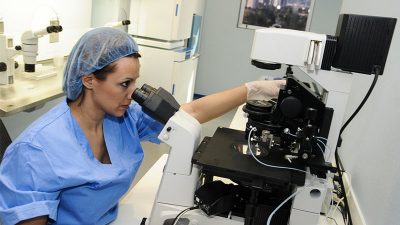Preimplantation Genetic Testing ( PGT)
Preimplantation Genetic Testing ( PGT) is a technique used to study the DNA of the ovules or embryos, in order to select the ones that are healthy. It involves looking for genetic and chromosomal abnormalities and is performed within an in vitro fertilization cycle, before carrying out the embryo transfer,so as to avoid the transmission of hereditary diseases.
What is Preimplantation Genetic Testing?
The steps are the same as for an in vitro fertilization cycle, except that at a certain point in the cycle, a biopsy must be performed on the eggs or embryos to extract the genetic material that is to be analyzed and thus find out which ones of the eggs or embryos are free from a genetic disease.
Preimplantation Genetic Testing with embryos
Within an in vitro fertilization cycle, once the eggs have been inseminated by conventional IVF or ICSI, and before transferring the resulting embryo to the uterus, its genetic material is studied to detect if there is any specific genetic alteration.
- It enables the detection of paternal and maternal chromosomal abnormalities.
After the insemination, the development of the embryos that have been correctly fertilized (between 2 and 5 days) is monitored in the laboratory. Day by day the cleavage of the embryos into an increasing number of cells (blastomeres) is monitored.
To carry out the genetic analysis of the embryos, a biopsy will be performed, usually on day 5, although sometimes if the embryo grows slowly, it might be on day 6 and even 7. At that point, the embryo is made of about 200 cells. The biologist only extracts 4-6 cells, enough to carry out the study.
After genetic analysis, the embryos that have a normal genetic and/or chromosomal endowment and adequate morphological characteristics will be the ones transferred to the maternal uterus, and if there are spare healthy embryos, they will be frozen.
Preimplantation Genetic Testing with ovules
Within an in vitro fertilization cycle, once the eggs have been retrieved by follicular puncture, and before being inseminated in the laboratory, their genetic material is studied to detect if there is any specific genetic alteration before the embryo is formed.
- It only enables the detection of maternal chromosomal abnormalities.
With this technique, a specific part of the ovule is analyzed: the polar body. To do so, a biopsy of the polar body is carried out, through an opening drilled in the coat that surrounds the ovule (zona pellucida). Once the polar body is extracted with a pipette, the eggs are inseminated by ICSI and remain in the incubator awaiting diagnosis.
After two days, the genetic result of the polar body is obtained. Embryos that after genetic analysis have a normal genetic and/or chromosomal endowment and adequate morphological characteristics will be the ones transferred to the maternal uterus, and if there are spare healthy embryos, they will be frozen.
What hereditary diseases does the PGT detect?
Any genetic disease whose mutation or failure in the gene that is causing it is known can be studied through Pre-implantation Genetic Testing.
For whom is this test indicated?
Preimplantation Genetic Testing is indicated for
- Couples in which one or both members are affected by a hereditary genetic disease, either dominant or recessive.
- Couples in which one or both members are affected by a genetic abnormality (translocations, inversions, etc.).
- Repeated failure in conventional in vitro fertilization or ICSI cycles.
- Repeated embryo implantation failures.
- Repeated abortions.
- Advanced maternal age.
- History of an abortion and/or of a pregnancy with chromosomal abnormalities.
- Some cases of male infertility.
- HLA typing




